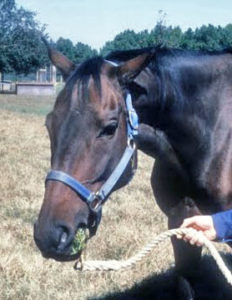A horse’s teeth should be examined every 6 months
Just like cats and dogs, horses need oral examinations from veterinarians. The health of a horse’s mouth greatly impacts its well-being, behavior, and performance. Dr. Dennis French, a professor who heads the Department of Veterinary Clinical Medicine at the University of Illinois, has cared for many horses with dental problems.
Unique Set of Choppers
“A horse’s teeth continually erupt out of the horse’s jaws throughout its lifetime,” says Dr. French. Species that evolved to exist on a diet of tough grasses—such as horses, cows, rabbits, and other rodents—share this trait. This ongoing eruption of the teeth can present challenges for these species.
Horse teeth are organized into two sections: the incisors and the cheek teeth. The incisors are found in the front of the horse’s mouth and are the easiest to see. The cheek teeth include the pre-molars and molars and are located on the sides of the mouth. The incisors grasp and tear food, while the cheek teeth grind the feed.
“Horses chew their feed in a circular motion. This leads to uneven wear on the teeth and various sharp points can form,” Dr. French explains. If this is not caught and corrected quickly, it can really tear up the mouth and leave sores, affecting the horse’s ability to eat and even perform. For this reason, horses should have their mouths examined by a veterinarian every six months, typically during a routine wellness check-up or when vaccines are administered.

Signs of Dental Issues
“There are many signs that a horse is having dental issues, some obvious and others more subtle,” Dr. French says. One obvious sign is quidding. Quidding is where a horse will loosely chew and ball up its feed instead of grinding it like normal. This is typically a sign of mouth pain. Other obvious signs include dropping feed while chewing, nasal discharge, bad-smelling breath, weight loss, and facial swellings.
Behavior or performance changes in the horse can indicate there is a dental issue. A horse that feels oral discomfort in its mouth can act out or perform poorly. “If an owner is having trouble with discipline in a horse who is used to bridle and saddle, I often suspect the problem could be a comfort issue within the mouth,” says Dr. French.
Spotting the Problem
An oral examination must be performed to determine if there really is a dental issue.
“It is so important to not only look in the mouth, but also feel,” says Dr. French. A veterinarian knows how to safely examine and palpate (meaning to feel) the horse’s mouth to note any issues or discomfort. Doing this, Dr. French will notice if any teeth are loose, missing, or have sharp edges. Locating the issue is the best way to determine what can be done to fix it.
Correcting the Issue
Correcting a dental problem in a horse is called floating the teeth.
“Floating a horse’s teeth means to file or rasp the teeth to reduce the sharp edges and make the surface smoother” Dr. French explains. A veterinarian does this with tools called dental floats, which are metal files on the end of a long metal handle that allows the veterinarian to reach into the horse’s mouth safely. Each of these files comes in different textures, sizes, and shapes in order to better reach a certain tooth.
Floating a horse’s teeth fixes misalignment or sharp edges that have developed. The horse will feel much better, symptoms will subside, and the horse’s teeth will not be harmed because they continue to erupt.
“Although not every horse will need to be floated every year, each horse should still be checked,” says Dr. French. Prevention is the best medicine after all.
If you want more information about floating teeth or if it is time to schedule your horse’s annual dental examination, contact your local veterinarian.
By Beth Pieper

![[horse teeth]](https://vetmed.illinois.edu/wp-content/uploads/2021/04/pc-horse-dentist.jpg)


